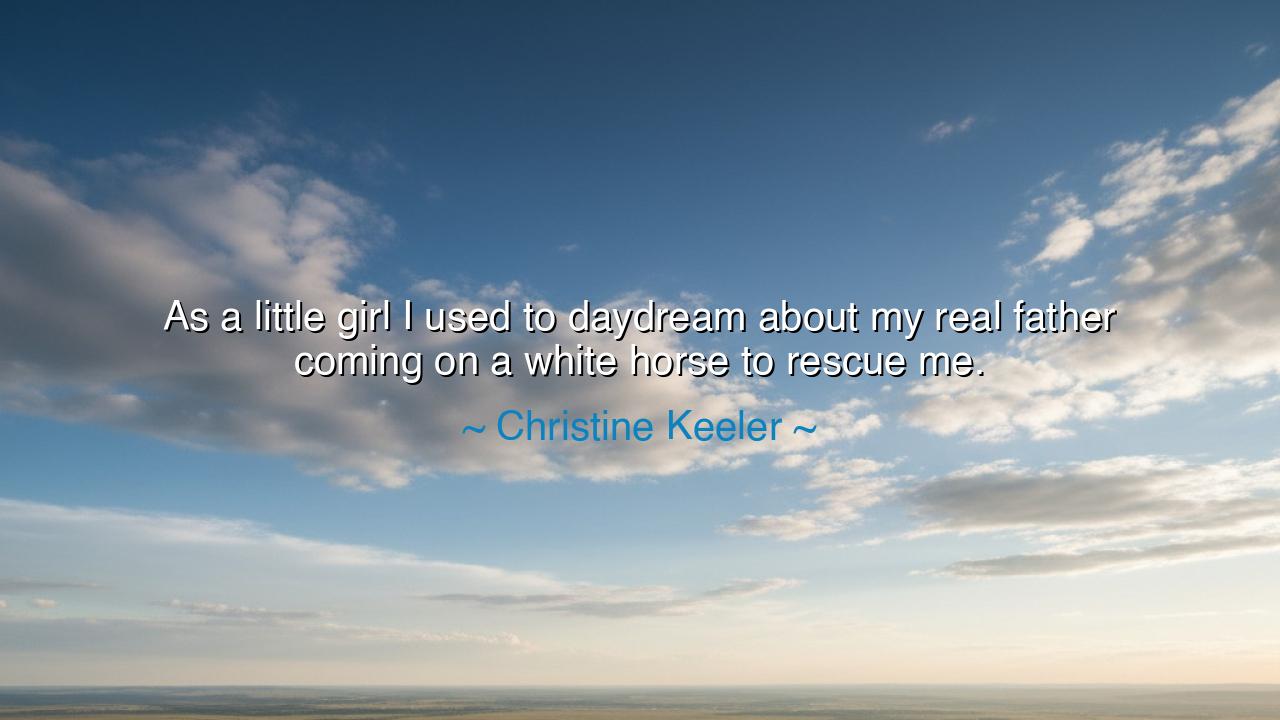
As a little girl I used to daydream about my real father coming
As a little girl I used to daydream about my real father coming on a white horse to rescue me.






The words of Christine Keeler—“As a little girl I used to daydream about my real father coming on a white horse to rescue me”—echo with the aching tenderness of longing and the eternal dream of salvation. Beneath their simplicity lies a truth as ancient as humankind itself: the yearning for protection, belonging, and unconditional love. In these words, Keeler reveals not merely a child’s fantasy, but a timeless symbol—the white horse, the emblem of hope and deliverance, of the ideal figure who arrives to make all wrongs right. It is the voice of innocence calling out to the world, believing still in rescue, believing still in goodness.
To the ancients, this image would have carried great weight. In every age, the hero on the white horse has appeared in myth and legend—the savior who rides through the darkness to bring justice and light. In the tales of Greece, it was Perseus, descending from the heavens to free Andromeda from her chains. In the sacred texts, it was the rider of revelation, a symbol of divine victory. To the hearts of the young, it is the father, the protector, the one who loves without condition. Keeler’s dream, therefore, was not vanity, but a sacred hope: that love might find her even in her loneliness, that someone might see her pain and lift her from it.
Christine Keeler’s life was not one of fairy tales, but of struggle. Born into hardship, she faced a world often cruel to the vulnerable. Her childhood lacked the safety that children should never have to dream about. And so, as she confesses, she turned to daydreams—the tender refuge of the wounded soul. Her “real father on a white horse” was not a man of flesh and blood, but the embodiment of everything she lacked: protection, affection, redemption. Like many before her, she transformed sorrow into imagination, and imagination into survival. The dream kept her spirit alive, even when the world seemed intent on breaking it.
The ancients would have recognized this as the power of myth within the heart. For myth does not belong only to gods and heroes—it dwells in every human longing. To imagine rescue is to believe, however faintly, that redemption is possible. Even in despair, the soul creates symbols of its own salvation. A white horse, a father’s embrace, a light in the dark—all are reflections of the eternal truth that the human spirit is drawn toward hope. And though life may never grant the literal rescue one imagines, the dream itself is a form of endurance.
Yet there is a deeper wisdom hidden within Keeler’s confession. The child waits for the rescuer, but the adult learns to become what she once longed for. The white horse does not always come from without—it must rise from within. To grow is to understand that salvation, though it may wear many faces, often lives in one’s own strength. What begins as dependence transforms into courage; what begins as longing becomes creation. The wise learn to be the rescuers of themselves, carrying within them the very light they once sought in others.
Consider the story of Joan of Arc, a young girl who, too, once dreamed of divine voices calling her to deliverance. But rather than waiting for her rescuer, she became one—riding not behind a savior, but at the head of armies. Her white horse was her own conviction; her armor, her faith. In her courage, we see the transformation of Keeler’s yearning: the evolution from hope for rescue to the power of becoming. The lesson is clear—the child dreams of being saved; the wise learn that courage is the truest salvation.
So, dear listener, let these words remind you that longing is not weakness—it is the birthplace of strength. Do not despise the part of you that dreams of rescue; it is the seed of the soul’s awakening. But when the time comes, rise from your waiting. Take up the reins of your own destiny. Be the one who rides forth—not on another’s horse, but on the will of your own heart. For while the world may fail to send your savior, it will never deny you the power to become one.
Thus, the quote of Christine Keeler becomes not a lament, but a quiet hymn of transformation. The little girl may have waited for her father’s white horse, but her words teach us that the truest rescue is self-forged. Hope begins in longing—but fulfillment begins in action. And when we finally learn to ride into our own storms, carrying the light we once sought in others, then we become, at last, both the dreamer and the hero of our own tale.






AAdministratorAdministrator
Welcome, honored guests. Please leave a comment, we will respond soon